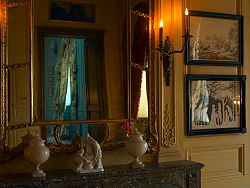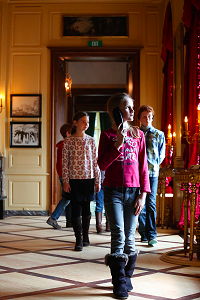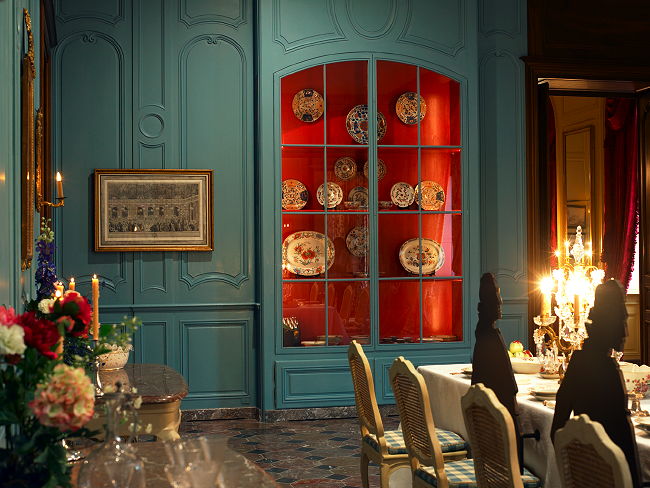Château de Prangins is bringing its past to life and showcasing its historical heritage. From 23 March 2013 the former reception rooms, comprising the salon, dining rooms and libraries, will be revealed in their original grandeur as the backdrop for the new permanent exhibition devoted to the everyday life of a noble family in the Vaud region at the end of the 18th century. The exhibition explores important issues of cultural history such as wealth and property, family life, lighting and heating, household staff and access to knowledge.
 Detail of the salon © Swiss National Museum
Built at the start of the Enlightenment for Louis Guiguer, a prosperous financier of Swiss origin who is elevated to the nobility through his purchase of the baronial estate, Château de Prangins – an imposing building overlooking Lake Geneva – symbolises a successful ascent into the higher echelons of society. This is reflected in the four corner towers, the central courtyard and the arrangement of the apartments in a straight line known as an enfilade, making it possible to gauge the size of the château – and hence the wealth of its owner – at a single glance. This same enfilade, which serves as a suite of reception rooms, is home to the new permanent exhibition. The exhibition offers an insight into the life of a baron and the way in which he manages his estate, his duties and obligations, his family and social life, and his principal interests. Each of the nine rooms is devoted to a specific topic that mirrors its original function: hospitality in the salon, servants in the butler’s pantry and private writing in the study.
The 1797 inventory
The best-known period in the building’s history coincides with the presence of Baron Louis-François Guiguer, the grandnephew of Louis. From his arrival in 1771 to his death in 1786, he keeps a journal in which he records episodes from his daily life and details the preoccupations of an enlightened gentleman and family father. The exhibition has been designed around this exceptional historical record. The journal acts as a thread running through the tour: a quotation from it introduces the topic for each room, while extracts examine it in more detail. In 1787, one month after Louis-François Guiguer dies leaving three young children and a pregnant widow, a notary draws up an inventory of his assets. It lists, room by room, all the furniture, paintings, engravings, items of tableware and silverware, mirrors, musical instruments and other objects that belonged to the baron, almost all of which have been dispersed over time. The only surviving document to record these details, the inventory served as the framework for the recreation of the appearance of the reception rooms at Château de Prangins.
 Enfilade and audioguide © Swiss National Museum
A team of exhibition designers and architects worked on every aspect of the architectural backdrop: ceilings, parquet floors, skirting boards and walls. The
boiseries have been restored to their original colours with the help of surveys carried out in the 1980s and 1990s. A false-marble decoration was recreated using a surviving fragment of the original. One important aspect of the décor is the textiles: the 1787 inventory contains precise details of the wall coverings and curtains that were in place at the time of Baron Louis-François Guiguer. Great care has been taken in selecting these fabrics and their designs, and in imitating as faithfully as possible the weaving and fitting techniques of the 18th century. Extensive research in the extensive collections of furniture and decorative arts belonging to the Swiss National Museum has unearthed more than 600 objects from the time that have now been brought together here. Furniture made from precious woods, chandeliers and mirrors, porcelain tableware from China and Nyon, books, paintings, drawings and engravings, transport visitors into the world of luxury and refinement so beloved of the Enlightenment.
PUBLICATION:
• Noblesse oblige ! Life at a Château in the Eighteenth Century: a lavishly illustrated, 136-page colour catalogue published by 5 Continents. Available in French, English, German and Italian.
To see more illustrations, click on VERSION FRANCAISE at the top
of this page
| 









